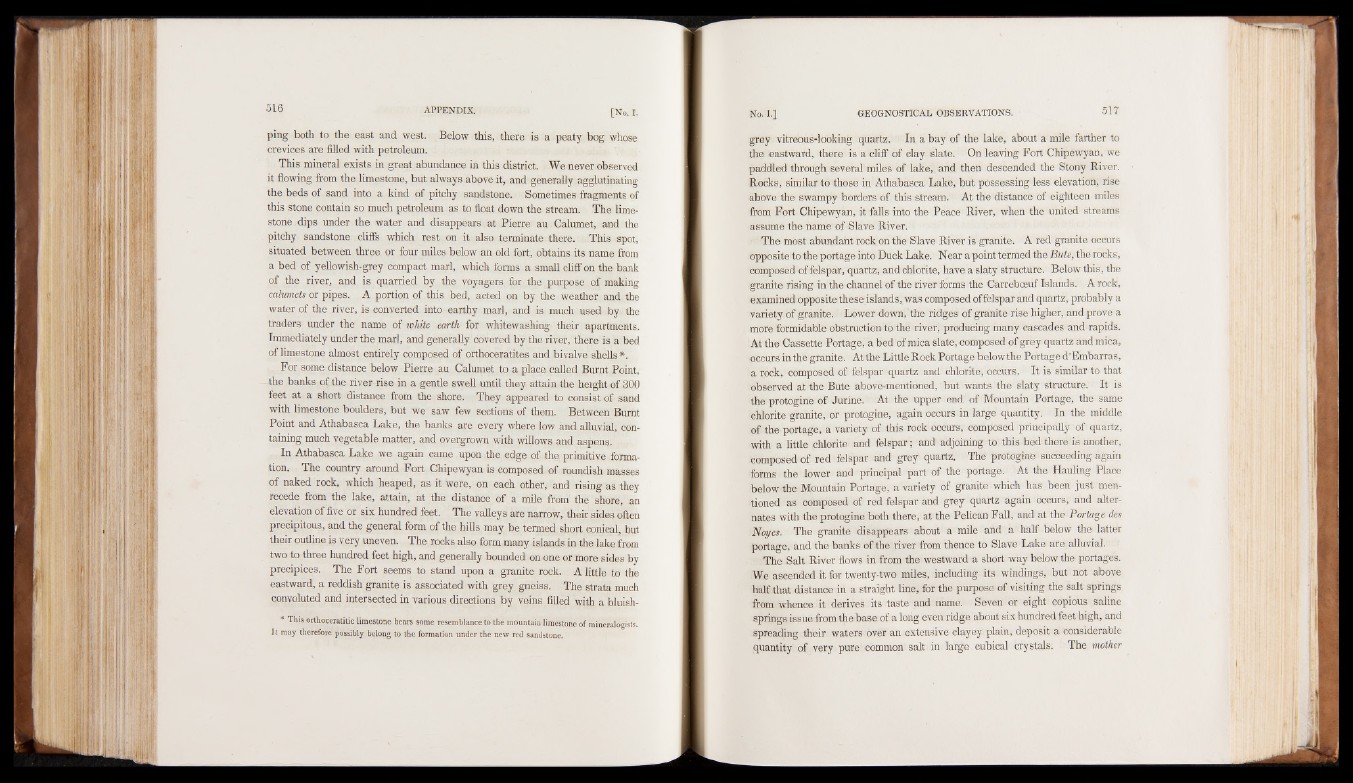
ping both to the east and west. Below this, there is a peaty bog. whose
crevices are filled with petroleum.
This mineral exists in great abundance in this district. We never observed
it flowing from the limestone, but always above it, and generally agglutinating
the beds of sand into a kind of pitchy sandstone. Sometimes fragments of
this stone contain so much petroleum as to float down the stream. The limestone
dips under the water and disappears at Pierre au Calumet, and the
pitchy sandstone . cliffs which rest on it also terminate there. This spot,
situated between three or four miles below an old fort, obtains its name from
a bed of yellowish-grey compact marl, which forms a small cliff on the bank
of the river, and is quarried by the voyagers for .the purpose , of making
calumets or pipes. A portion of this bed, acted on by the weather and the
water of the river, is converted into earthy marl, and is much used by the
traders under the name of white earth for whitewashing their apartments.
Immediately under the marl, and generally covered by the river, there is a bed
of limestone almost entirely composed of orthoceratites and bivalve shells *.
For some distance below Pierre au Calumet to a place called Burnt Point,
the banks of.the river-rise in a gentle swell until they attain the height of 300
feet at a- short distance from the shore. They appeared to consist of sand
with limestone boulders, but we saw few sections of them. Between Burnt
Point and Athabasca Lake, the banks are every where low and alluvial, containing
much vegetable matter, and overgrown with willows and aspens.
In Athabasca Lake we again came upon the edge of the primitive formation.
The country around Fort Chipewyan is composed, of roundish masses
of naked rock, which heaped, as it were, on each other, and rising as they
recede from the lake, attain, at the distance of a mile from the shore, an
elevation of five or six hundred feet. The valleys are narrow, their sides often
precipitous, and the general form of the hills may be termed short conical, but
their outline is very uneven. The rocks a}so form many islands in the lake from
two to three hundred feet high, and generally bounded on one or more sides by
precipices. The Fort seems to stand upon a granite rock. A little to the
eastward, a reddish granite is associated with grey gneiss. The strata much
convoluted and intersected in various directions by veins filled with a bluish-
* This orthoceratitic limestone bears some resemblance to the mountain limestone of mineralogists.
It may therefore possibly belong to the formation under the new red sandstone.
grey vitreous-looking quartz. In a bay of the lake, about a mile farther to
the eastward, there is a cliff of clay slate. On leaving Fort Chipewyan, we
paddled through several miles of lake, and then descended the Stony River.
Rocks, similar to those in Athabasca Lake, but possessing less elevation, rise
above the swampy borders of this stream. At the distance of eighteen miles
from Fort Chipewyan, it falls into the Peace River, when the united streams
assume the name of Slave River.
The most abundant rock on the Slave River is granite. A red granite occurs
opposite to the portage into Duck Lake. Near a point termed the Bute, the rocks,
composed of felspar, quartz, and chlorite, have a slaty structure. Below this, the
granite rising in the channel of the river forms the Carreboeuf Islands. A rock,
examined opposite these islands, was composed of felspar and quartz, probably a
variety of granite. Lower, downj'the ridges of granite rise higher, and prove a
more formidable obstruction to the river, producing many cascades andrapids.
At the Cassette Portage; a bed of mica slate, composed of grey quartz and mica,
Occurs in the granite. At the Little Rock Portage belowthe Portage d’Embarras,
a rock, composed of. felspar quartz and chlorite, occurs. It is similar to that
observed at the Bute above-mentioned, but wants the slaty structure. It is
the protogine of Jurine. At the upper end of Mountain Portage, the same
chlorite granite, or protogine, again occurs in large quantity. In the middle
of the portage, a variety of. this rock occurs, Composed principally of quartz,
with a little .chlorite and felspar; and adjoining to this bed there is another,
composed of red felspar and grey quartz. The protogine succeeding again
forms the lower and principal part of the portage. At the Hauling Place
belowthe Mountain Portage, a variety of granite which has been just mentioned
as composed of red felspar and grey quartz again occurs, and alternates
with the protogine both there, at the Pelican Fall, and at the Portage des
Noyes. The granite disappears about a mile and a half below the latter
portage, and the banks of the river from thence to Slave Lake are alluvial.
The Salt River flows in from the westward a short way below the portages.
We ascended it for twenty-two miles, including its windings, but not above
half that distance in a straight line, for the purpose of visiting the salt springs
from whence it derives its taste and name. Seven or eight copious saline
springs issue from the base of a long even ridge about six hundred feet high, and
spreading their waters over an extensive clayey plain, deposit a considerable
quantity of very pure common salt in large cubical crystals. The mother